 Apple Computer shares dropped Tuesday as Sony relaunched its famous Walkman line amongst concerns that increased competition from Napster might impact its dominance of online music and portable players.
Apple Computer shares dropped Tuesday as Sony relaunched its famous Walkman line amongst concerns that increased competition from Napster might impact its dominance of online music and portable players.
The soaraway success of the iPod music player has transformed Apple’s balance sheet and its stock price, with the company shining as one of the best performers in the Nasdaq technology index over the past year.
But some industry pundits are predicting that Apple is being damaged by serious competition from a new generation of smaller, sleeker and cheaper MP3 players from the likes of Sony, Rio and Creative and a host of online music services led by Napster.
Shares of Apple have dropped 8.5 percent since the announcement of the stock split on 11 February, and have fallen some 6 percent this week alone.
“Competition concerns are certainly going to influence how this stock trades,” said Warren West, principal at Philadelphia-based GreenTree Brokerage Services, which executes trades for institutional investors such as asset managers and hedge funds. “Investors in general have enjoyed the stock moves, there’s a lot of money that has been made, and people are going to start taking profits _ especially after the split.”
 Over the last twelve months, Apple’s share price has gone from US$23 (€17/£12) to an all-time high of US$81.99 (€61/£42) just before the split was announced.
Over the last twelve months, Apple’s share price has gone from US$23 (€17/£12) to an all-time high of US$81.99 (€61/£42) just before the split was announced.
Investors must now decide if the company’s share price can maintain its strength in the face of a market getting becoming increasingly crowded with rival products.
Sony are aggressively targeting the iPod with their Walkman line of digital music players, hoping to woo customers with lightweight and compact flash memory players instead of bulkier, hard drive-based units.
In fact, many of the new iPod alternatives aren’t trying to compete with Apple’s player at the high end but are focussing on consumers who are choosing between cheaper, lower-storage-capacity flash-media players and pricier, entry-level hard-drive players that hold more than 1,000 songs.
The Sony flash-media players will be knocked out for as low as US$130 (€97/£68) – not as cheap as the new iPod Shuffle, but considered to be better value because of a longer battery life and more features.
“Flash is going to be here for a while, because it’s more affordable,” Kelly Davis, product manager for Sony Electronics, says. “People are trying to get more capacity for their dollar.
The new Sony players are expected to give the company the No. 2 position in the portable music player market by next year.
Apple’s iTunes service is also coming under attack, with rival Napster recently boosting its sales outlook with growing demand for its new “Napster To Go” subscription service, expected to generate US$15 million for its fiscal fourth quarter.
Apple is also experiencing competition from music services offered by rivals such as Microsoft Corp., Real Networks, and Yahoo.
The company still remains in good shape though, with Piper Jaffray analyst Gene Munster predicting continuing good sales for the iPod line.
“Our checks have left us more confident that demand for Apple’s key products most notably iMac, Powerbook, Mac mini and various versions of the iPod continue to be ahead of expectations,” Munster told clients in a research report. “We anticipate that strong demand across various segments of the company will allow Apple to exceed Wall Street estimates for overall revenue and earnings.”
Munster expects the company to report earnings of US$1.04 (€0.77 /£0.53) per share on revenue of US$12.81 billion in 2005, up from previous expectations of a 98% share profit on sales of US$12.25 billion.
Piper Jaffray told clients it expects Apple to sell 3.8 million iPods during the second quarter, including 1 million iPod shuffle models, followed by 4.6 million iPods during the third quarter, with the Shuffle model accounting for 1.8 million of the sales.
Apple Shares Fall on Sony, Napster Fears (PA)
Sony MP3 players
Apple iPod
 I had a Sony W800 Walkman Phone in my hands for the first time today at the Sony Media Experience in Bordeaux. There’s already been a terrific buzz about this camera and it was great to get my hands on the thing during what Sony claims was its first European outing.
I had a Sony W800 Walkman Phone in my hands for the first time today at the Sony Media Experience in Bordeaux. There’s already been a terrific buzz about this camera and it was great to get my hands on the thing during what Sony claims was its first European outing.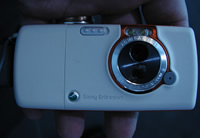 The central music button is the focus of the handset and, not surprisingly, pressing it takes you straight to your music selection.
The central music button is the focus of the handset and, not surprisingly, pressing it takes you straight to your music selection. The software comes with the handset will take music CDs straight from the player on your machine to handset, without intervention.
The software comes with the handset will take music CDs straight from the player on your machine to handset, without intervention.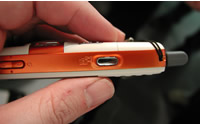
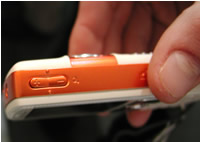

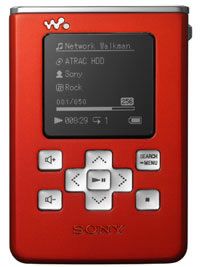 iPod killers, eh? You can barely get out of bed without some hyperbolic company boldly giving their new MP3 player the big one, only to discover that it’s proved as popular as a lager lout on a teatotallers daytrip.
iPod killers, eh? You can barely get out of bed without some hyperbolic company boldly giving their new MP3 player the big one, only to discover that it’s proved as popular as a lager lout on a teatotallers daytrip. When it comes to battery life, the Sony has taken the iPod around the back of the bike sheds and given it a good thumping.
When it comes to battery life, the Sony has taken the iPod around the back of the bike sheds and given it a good thumping. Unlike previous Sony models, the NW-HD5 is based around a portrait design where the seven line, 1.5-inch backlit LCD sits above the controls. In a neat twist, the new ‘Follow Turn Display’ feature automatically orients the interface screen horizontally or vertically depending on which way the player is held.
Unlike previous Sony models, the NW-HD5 is based around a portrait design where the seven line, 1.5-inch backlit LCD sits above the controls. In a neat twist, the new ‘Follow Turn Display’ feature automatically orients the interface screen horizontally or vertically depending on which way the player is held.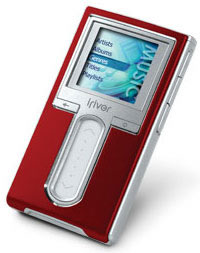 Shipments of MP3 players soared by an enormous 116% in 2004, as hundreds of wallet-tempting products arrived in response to the phenomenal success of Apple iPod player, according to a survey by Market Intelligence firm, iSuppli.
Shipments of MP3 players soared by an enormous 116% in 2004, as hundreds of wallet-tempting products arrived in response to the phenomenal success of Apple iPod player, according to a survey by Market Intelligence firm, iSuppli. The iSuppli report also predicts that HDD-based MP3 player shipments will grow by a CAGR of 41.8% from 2004 to 2009, as compared to 22.9% for flash-based players.
The iSuppli report also predicts that HDD-based MP3 player shipments will grow by a CAGR of 41.8% from 2004 to 2009, as compared to 22.9% for flash-based players.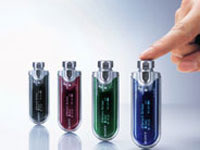 Apple Computer shares dropped Tuesday as Sony relaunched its famous Walkman line amongst concerns that increased competition from Napster might impact its dominance of online music and portable players.
Apple Computer shares dropped Tuesday as Sony relaunched its famous Walkman line amongst concerns that increased competition from Napster might impact its dominance of online music and portable players. Over the last twelve months, Apple’s share price has gone from US$23 (€17/£12) to an all-time high of US$81.99 (€61/£42) just before the split was announced.
Over the last twelve months, Apple’s share price has gone from US$23 (€17/£12) to an all-time high of US$81.99 (€61/£42) just before the split was announced. (CeBIT, Hannover) Wandering around the Sony products at the pre-CeBIT press conference, I came across the DSC-T7, the smallest, sexiest model whos roots lay with the DSC-T1.
(CeBIT, Hannover) Wandering around the Sony products at the pre-CeBIT press conference, I came across the DSC-T7, the smallest, sexiest model whos roots lay with the DSC-T1.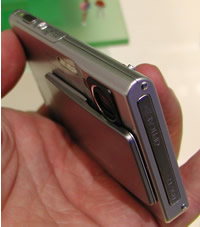 a sliding cover that both covers and protects the lens and switches the camera on. Measuring only 14.8 mm / 0.6 in at the lens cover, and 9.8 mm / 0.4in for the main body, it packs 5.1m pixel. The back is taken up with a 2.5″ TFT Hybrid LCD, displaying 230,000 pixels.
a sliding cover that both covers and protects the lens and switches the camera on. Measuring only 14.8 mm / 0.6 in at the lens cover, and 9.8 mm / 0.4in for the main body, it packs 5.1m pixel. The back is taken up with a 2.5″ TFT Hybrid LCD, displaying 230,000 pixels.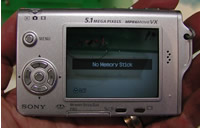
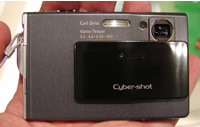 Nothing definite on release dates or price but the talk in the corridors is it should be around in May for around 375Euro, $500, 260 UKP.
Nothing definite on release dates or price but the talk in the corridors is it should be around in May for around 375Euro, $500, 260 UKP.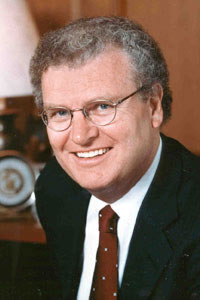 In an extraordinary move, Sony has named the Welsh-born head of its US operations, Sir Howard Stringer, as chairman and chief executive – a rare move for a major Japanese company to give its top post to a foreigner.
In an extraordinary move, Sony has named the Welsh-born head of its US operations, Sir Howard Stringer, as chairman and chief executive – a rare move for a major Japanese company to give its top post to a foreigner. When Sony start slapping the world famous Walkman mobile music brand on their products, you know that they mean business, and their new Sony Ericsson W800 has been proudly trumpeted as the first mobile phone to combine a high-quality digital music player and a 2 Megapixel camera.
When Sony start slapping the world famous Walkman mobile music brand on their products, you know that they mean business, and their new Sony Ericsson W800 has been proudly trumpeted as the first mobile phone to combine a high-quality digital music player and a 2 Megapixel camera. Sadly, we’re going to have to wait a while before we can start adjusting our lifestyle behaviour – the release of the Sony Ericsson W800 is not scheduled until the third quarter of 2005
Sadly, we’re going to have to wait a while before we can start adjusting our lifestyle behaviour – the release of the Sony Ericsson W800 is not scheduled until the third quarter of 2005 Microsoft is teaming up with one of Japan’s hotshot video game developers to create games for its next-generation video game console, XBox2 – a sure-fire sign that it’s determined to grab a fat slice of the Japanese market.
Microsoft is teaming up with one of Japan’s hotshot video game developers to create games for its next-generation video game console, XBox2 – a sure-fire sign that it’s determined to grab a fat slice of the Japanese market.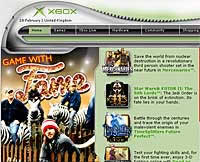 A founding member of former video game software developer Square Co., the 42-year-old is famed for creating the role-playing series, ‘Final Fantasy’, which has shifted more than 60 million copies to date.
A founding member of former video game software developer Square Co., the 42-year-old is famed for creating the role-playing series, ‘Final Fantasy’, which has shifted more than 60 million copies to date. Sony has announced that it is to end production on its Clie line of PDAs in Japan.
Sony has announced that it is to end production on its Clie line of PDAs in Japan. Our guess is that they’re going to focus their energies on ramping up the feature list on Sony Ericsson smartphones, developing the PlayStation Portable and finally producing the iPod killer they so desperately need.
Our guess is that they’re going to focus their energies on ramping up the feature list on Sony Ericsson smartphones, developing the PlayStation Portable and finally producing the iPod killer they so desperately need.